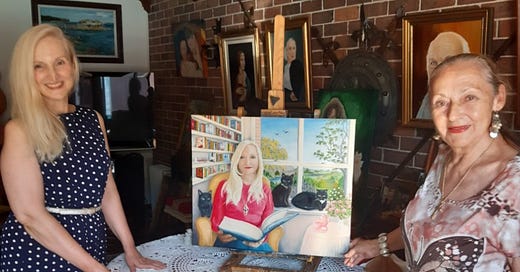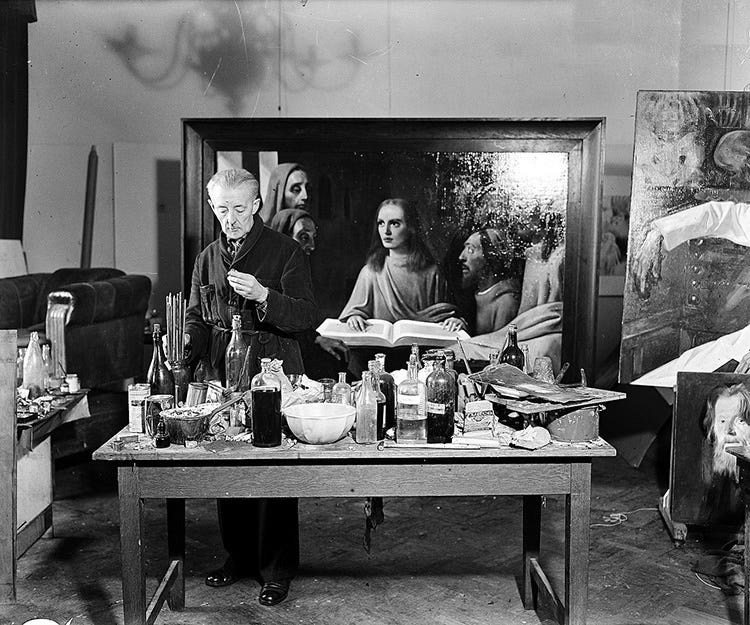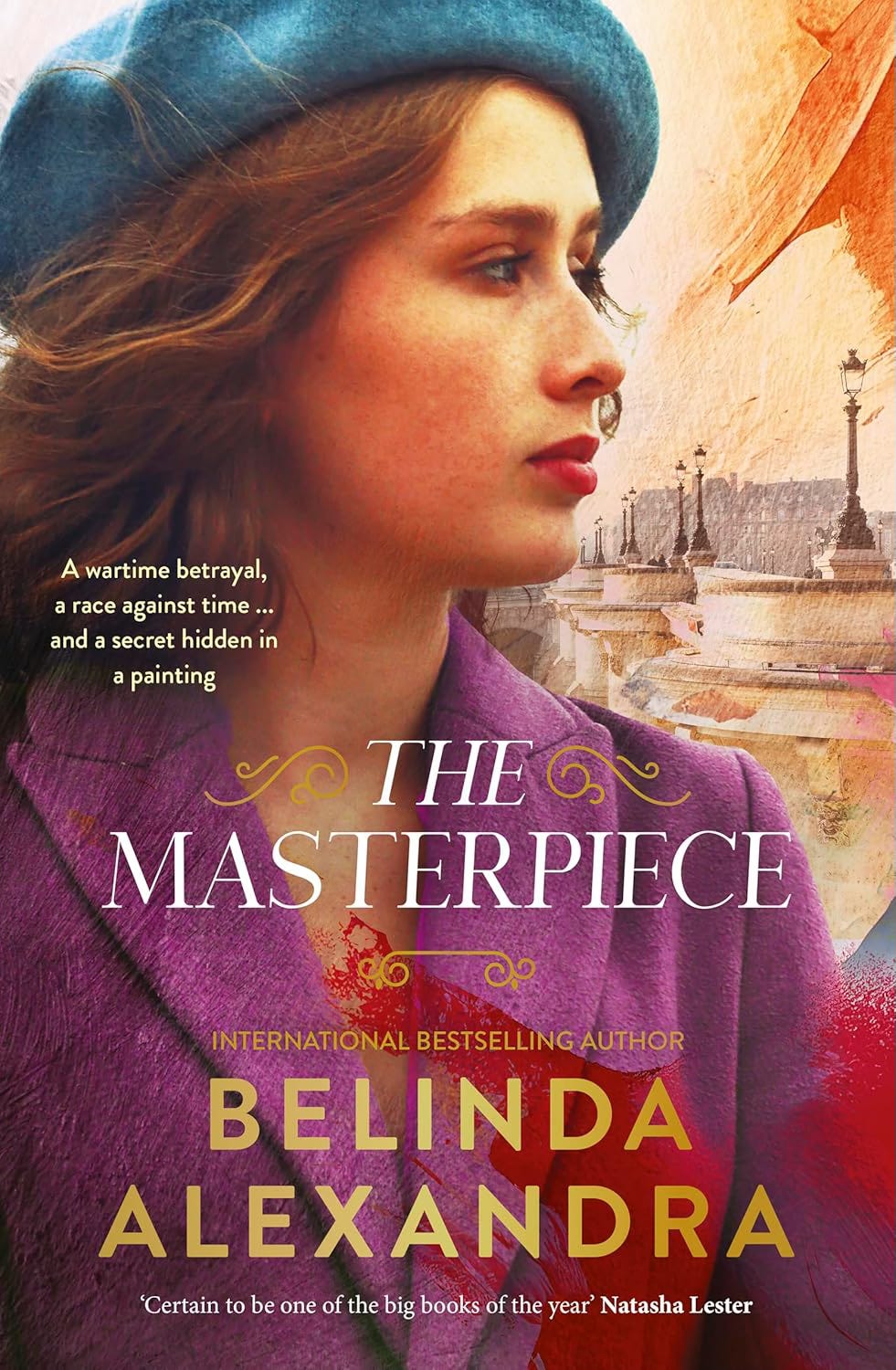Hi, Lovely Subscribers,
Here we are in June! It’s freezing winter weather here in Sydney but being one to find the best in every season, I’m rather enjoying snuggling under a throw rug with the kitty-cats and losing myself in reading. I did have plans of working in my garden in the space between handing in my manuscript for The Italian Correspondent to my publisher and receiving it back for the first round of editing, but three weeks of continuous heavy rain put an end to that idea. Instead, I’ve started the research for my next book set during the French Revolution, and have become so engrossed in that, I think my poor garden might be neglected until spring.
Last month, my friend Carmen Maravillas, an artist, and I did brave the rain to drive up the coast to speak at the Avalon Community Library as a dynamic duo. I spoke about the inspiration for my art mystery novel, The Masterpiece, and she enthralled everyone by explaining the techniques that are used these days to root out fake artworks. It’s estimated that around 20 percent of art in national galleries around the world are forgeries.
It was a timely discussion with all the interest in what AI means for artists and other creatives. Having your work copied and stolen – or the potential for it – is humiliating and disempowering.
But while AI is viewed as a villain in this aspect, interestingly art forgers often obtain the status of folk heroes. They are viewed largely as mavericks, pulling the wool over the eyes of the elite and elusive art establishment. Even after they are caught and serve jail time, they obtain a mythical status. John Myatt who is considered the greatest art fraud of the 20thCentury, now makes a lavish living selling certified forgeries through his website ‘Genuine Fakes’.
Because it was such an interesting topic, I thought I’d summarise some of what was discussed during the talk for my subscribers.
THE PARIS ART MARKET BOOMED DURING THE WAR
In The Masterpiece, a young woman named Eve Archer arrives in Paris to find Serge Lavertu, an important art dealer and the father she never knew. But before she can summon the courage to tell him who she is, Serge is arrested, accused of selling a French national treasure to Hitler during the war and murdering the original owner to obtain it. Could Serge truly be guilty of treason, or has he been set up? Only one person knows the truth that might save Serge from execution: Kristina Belova, a beautiful Russian artist recently returned from a concentration camp and who is suffering amnesia. As Eve desperately prompts Kristina to recall what happened during the war, she uncovers a passionate love triangle and a secret about her own heritage that will change her view of life forever.
From the research I had done for previous books set during the Nazi occupation of France, my picture of the country at the time was a place where the people were starving to death on severe rationing, freezing in their homes with no sources of heat, and any resistance was brutally put down.
I was surprised to learn that the Paris art market boomed at this time and that many dealers and collectors made millions of dollars. That made me curious to discover how a small group of art dealers became so rich.
Many of us know that the Nazis plundered Europe. While the Holocaust is seen as being fuelled by racism, the more research I do about the era, the more I become convinced that it was fuelled by greed and that racism against the Jewish population was a convenient excuse to strip them of their wealth and their daily possessions: Everything from their kitchen equipment, to their clothing and even, most gruesomely, their gold tooth fillings.
When Jewish people fled France, sensing something dreadful was about to happen, they weren’t allowed to take much with them, and so many were forced to sell their art collections at bargain prices. Later, during the Holocaust these collections were simply stolen by the Nazis with no compensation. If a fleeing Jewish collector had hidden their art collection in a bank vault or with friends, very often their fellow Aryan art dealers revealed to the Nazis where these collections were hidden. In exchange for their treachery, the French art dealers received a commission of some of the plundered art works.
Both Hitler and his right-hand man, Hermann Göring, had insatiable appetites for art. Hitler was plundering Europe of its art to stock a super museum he was planning to build in his hometown of Linz in Austria. Göring was a greedy collector of many things including jewels, furs and household décor as well as art.
The Nazis were interested in classical, heroic and Renaissance art in keeping with their fascist aesthetic. They saw modern art movements like Cubism, Futurism, and Dadaism as decadent and harmful to society. The regime labelled the art from these movements as "degenerate". But contrary to popular belief, they didn’t burn modern art. They simply sold it to the French art dealers to raise further funds for the German war effort.
French citizens who had cash to spare would then buy these paintings. The French franc had been so badly devalued by the occupation, and so hampered by inflation, it made more sense to spend money on something that would be a future investment than to keep cash in a bank or under a mattress.
France lost a third of its important artworks at this time, and about twenty percent has never been recovered. But even when a work is found and categorised for restitution, tragically there are often no surviving family members of original the Jewish owner to be compensated for the theft.
THE ART FORGER WHO INSPIRED THE MASTERPIECE
The spark of inspiration for The Masterpiece came from the story of a Dutchman named Han Van Meegeren.
Holland suffered dreadfully during the occupation by the Nazis. If you have read The Diary of Anne Frank you know how harrowing it was for Jews in hiding. Even the non-Jewish population suffered during the famine that resulted from the German blockade.
After the Allied victory, there was a quick reckoning for those who had collaborated with the Nazis. Perfunctory trials carried out in the evening were rapidly followed by the firing squad at dawn.
Van Meegeren was of those arrested. He had made an obscene amount of money during the war and had thrown lavish parties where the guests included high profile Nazis and Dutch collaborators. But even more seriously, a paper trial revealed that he had committed treason by selling a Dutch national treasure – a painting by revered artist Johannes Vermeer, to Göring for an exorbitant sum. But before his certain execution, Van Meegeren made and extraordinary claim: The painting he’d sold was a forgery by his own hand. And furthermore, there were several other important works by Vermeer hanging in Dutch national museums that had also been painted by him.
At first, nobody believed him. His only way to prove his claim was to convince the authorities to bring him his art supplies and he would show them step-by-step how he had managed to fool some of the most elite art specialists in the world. Van Meegeren revealed that he had spent years perfecting his forgery techniques. The biggest problem he faced was getting oil paint to harden thoroughly, a process that normally takes 50 years. He solved the dilemma by mixing his pigments with a synthetic resin, Bakelite (yes, the same substance used to make telephones and other household objects), instead of oil, and subsequently baking the canvas in an oven at 100 °C to harden the paint. He would then roll the canvas over a cylinder to create the effect of craquelure before washing black India ink into the cracks to create the illusion of age.
After this demonstration, rather than being reviled as a collaborator, Van Meegeren was hailed as a national hero. After all, he had forced Göring to pay a huge sum in paintings to acquire the work. It was said that after the war, when Göring was captured but remained unrepentant of his horrific war crimes, his face fell when he learned his beloved Vermeer was a forgery. But even more so, Van Meegeren had shown up the art establishment – they didn’t seem to know much more than the average person about art, something many had suspected.
Van Meegeren was much more than a skilled art forger, however. He was an excellent conman. Without his ability to charm and persuade people that what they were seeing was the real deal, even the finest art forgery may not have passed muster.
Van Meegeren learned early on that it was the story one spun around a work that gave it its magic. When he was an art student he drew a fawn as part of a competition. The drawing was good, but it was when Van Meegeren added the off-the-cuff remark that it was Princess Juliana’s favourite deer, things really took off. Princess Juliana was a popular member of the Dutch royal family, equivalent to the late Princess Diana of the British monarchy. As soon as he made this statement, the drawing went ‘viral’ and it is estimated that at the time 1 in 5 Dutch households had a print of it hanging in their homes. It was equivalent to the silver pineapple or a llama with a cactus planter in home décor today.
Van Meegeren used his story telling ability to convince the renowned museum director, Dirk Hannema, to buy his first forged Vermeer. Hannema had written a book suggesting the known Vermeer paintings seemed to be from either the early or late part of the artist’s career, but that there must have been a period in between and those paintings had not yet been discovered, if they still existed.
Van Meegeren knew it might be difficult to pull off a forgery too close to Vermeer’s known works, so he decided to create something that could appear to be from this middle period. He further enhanced his deception by creating a story of an important Dutch family, now fallen on hard times, who had to sell their precious painting. Hannema’s blind desire to be the first to discover a Vermeer painting from his proposed missing period did the rest as his imagination ran wild.
But perhaps Van Meegeren’s final con was to convince the Dutch people that he was a hero in having fooled such a high-profile Nazi as Göring, as well as the art establishment. The reality is that not one cent of the money Van Meegeren made from the forgery went towards helping the Dutch Resistance or Jews in hiding. It all went on his hedonistic lifestyle. At the time of his arrest, Van Meegeren owned over 50 different houses, many of which would certainly have been stolen from Jewish families.
But the final betrayal came after the war when a book of water colours and drawings inscribed by Van Meegeren to Hitler was found in Hitler’s library in Berlin. Yet, again Van Meegeren attempted to wiggle his way out of that awkward revelation by stating that while the signature was his, the affectionate inscription was not. Somebody else must have added it. Remarkably, Van Meegeren received only a 12 month sentence for forgery and fraud. The charges of collaboration were dropped. While waiting on appeal for the sentence, Van Meegeren died of a heart attack.
In The Masterpiece, I tell the story of a group of artists who forge art and sell it to Nazis to help fund an escape network for Jews trapped in France. It is an art mystery story and it’s also an epic love story. Perfect cosy winter reading (or for my northern hemisphere readers, a great book to lose yourself in while lying on the beach or swinging in a hammock). I hope you enjoy it!
If you enjoyed today’s article, please do subscribe. I also have two other newsletters that might interest you. See below.
Belinda XX










If I could wipe my brain to read The Masterpiece again for the first time, I would. It's that good. Lucky for me my memory is pretty rubbish, so I will just happily read it again in a year or so 😄
LOVE this. Layer upon layer of intrigue. My favourite B.A. Masterpiece yet!